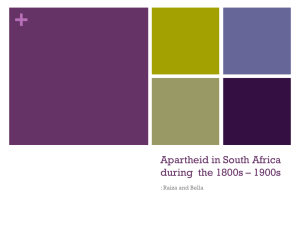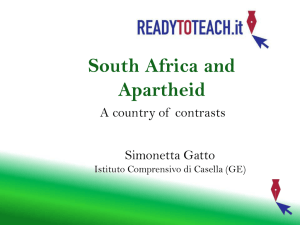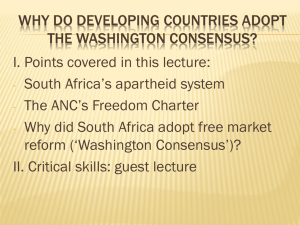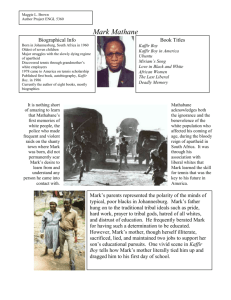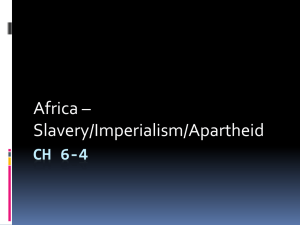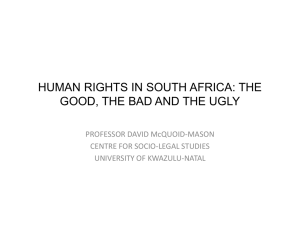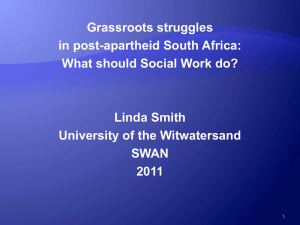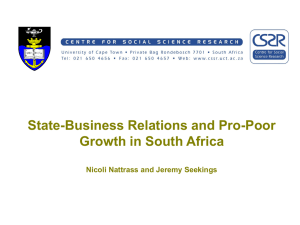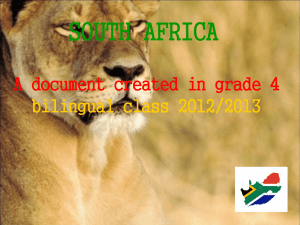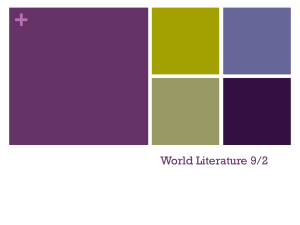Kaffir Boy PP - Haiku Learning : Login
advertisement
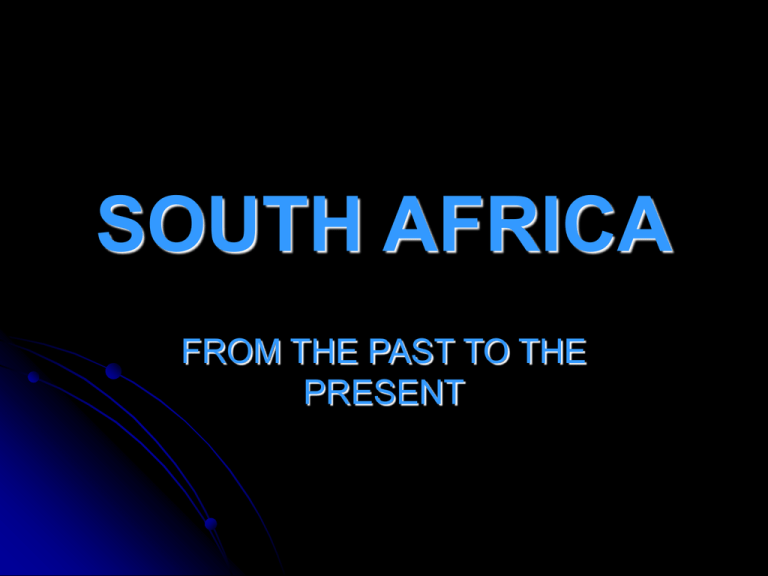
SOUTH AFRICA FROM THE PAST TO THE PRESENT Before whites came to South Africa, the Western area was sparsely populated by two groups of Native Africans: the Khoikhoi and the San. These groups included Xhosa and the Zulu tribes. Many of these cultures were common to many Africans in southern Africa. Extended families were very strong Men were heads of the family Children respected their elders Gender specific roles were assigned People are people through other people Though black Africans have always lived in what is known as South Africa, European settlers began to farm there in the 1600s Eventually taking away more and more land from the natives Later, given self rule by the British, the settlers united to form the Union of South Africa, with a constitution that gives whites almost complete power In control were the Afrikaners, whose leaders often viewed themselves as “civilized” people superior to non-whites, with a mission from God to rule South Africa In 1948, the Afrikaner Nationalist Party won control of the government D.F. Malan promised that if he won, he would preserve a pure white race After the election, apartheid became official government policy Apartheid: (meaning separatism) was a system of racial segregation that was enforced in South Africa from 1948 – 1991. Apartheid was designed to form a legal framework for continued economic and political dominance by people of European descent. The Laws of Apartheid Population Registration Act: Classified all South Africans as Bantu (black) Colored (mixed race) White Asian (consisting of Indians and Pakistanis) The Laws of Apartheid Group Areas Act: Set aside separate living areas and business districts for each race within cities; this law ensured that the white minority (about 1520% of the population) would own 80% of the land % of Land Owned Black SA White SA The Laws of Apartheid Influx Control Laws: Prohibited blacks from being in a white area for over 72 hours or from living in one of the black townships unless they had a job in a white home or business The Laws of Apartheid Pass Laws: Required all NON WHITES over the age of 16 to carry a passbook with important documentation such as birth date, race, tribal affiliation, and work history These identity documents became a passport to control the migration of Blacks to ‘white’ South Africa The Laws of Apartheid Mixed Marriages Act: Forbid marriages between whites and those of another race The Laws of Apartheid Bantu Education Act: Established separate, inferior schools for blacks where they were primarily taught about tribal life in tribal languages The Laws of Apartheid Bantu Homelands Citizenship Act: made every black South African, no matter where he/she lived, a citizen of 1 of the 10 homelands, but NOT of South Africa – this prevented nonwhite people – even if actually residing in South Africa – from having a vote or influence The Laws of Apartheid The Reservation of Separate Amenities Act: allowed the government to provide different levels of amenities for the different races Schools Hospitals Transportation An Apartheid Sign on a Durban beach in 1989 SA National Flag 1928-1994 Defines SA as an inherently white nation, recognizing the country’s British and Dutch ethnic roots, but offering no symbolic recognition of the black majority. SA National Flag 1994- present day Internal Resistance 1949 – ANC developed an agenda that for the first time advocated open resistance Strikes Acts of public disobedience Protest marches Sharpeville Massacre 1960 – a group of ANC members, seeking to sever ALL ties with the white government, broke away to form the more militant PAC Nationwide demonstrations took place against the hated “pass laws” March 21, 1960 Black people congregated in Sharpeville to demonstrate against the requirement for blacks to carry identity cards Estimates vary widely, from 5000 up to as many as 20,000 with larger figures coming from the police, wishing to stress how much danger they had been in The crowd converged on the local police station, singing and offering themselves up for arrest for NOT carrying their pass books. A group of about 300 police opened fire on the demonstrators, killing 69 and injuring 186 ALL victims were black, and most of them had been shot in the back The crowd was effectively unarmed; many witnesses stated that the crowd was NOT violent, but the senior officer stated, Hordes of natives surrounded the police station. My car was struck with a stone. If they do these things they must learn their lesson the hard way This day became known as the Sharpeville Massacre In its aftermath, the government banned the ANC and the PAC Resistance goes Underground To many domestic and international onlookers, the struggle had crossed a crucial line in Sharpeville, and there could no longer be any doubt about the nature of the white regime In the wake of the shooting, a massive stay-away from work was organized and demonstrations continued Prime Minister Verwoerd declared a state of emergency, giving security forces the right to detain people without trial Over 18,000 demonstrators were arrested, including much of the ANC and PAC leadership, and both organizations were banned Together, with ANC leader Nelson Mandela, they were tried for treason In 1964, Mandela and seven others were sentenced to life imprisonment for terrorism Activist against Apartheid Nelson Mandela Oliver Tambo, another member of the ANC leadership, managed to escape South Africa and was to lead the ANC in exile for the next 30 years The trial was condemned by the United Nations Security Council, and was a major force in the introduction of international sanctions against the South African government With the ANC and PAC banned, and Mandela and his fellow leaders in jail or exile, South Africa entered some of its most troubled times Apartheid legislation was increasingly enforced, and the walls between the races were built even higher In 1966 Verwoerd was stabbed to death, but his policies continued Black Consciousness Movement During the 70s, resistance again gained force spearheaded by the South African Students’ Organization under the charismatic leadership of Steve Biko This organization stressed the need for: Psychological liberation Black pride Non-violent opposition to apartheid In 1974, the government issued the Afrikaans Medium Decree which forced all schools for blacks to use the Afrikaans language This policy was deeply unpopular, since Afrikaans was regarded as the language of the oppressor April 30, 1976 – students at Orlando West Junior School went on strike, refusing to go to school This rebellion spread throughout Soweto The students organized a mass rally for June 16, which turned violent – police responded with bullets to the stones thrown by the students The official death toll on that day was 23, but some placed it as high as 200 The incident triggered widespread violence throughout South Africa, which claimed further lives INTERNATIONAL ICON: Hector Pieterson aged 12 One of the first casualties In September 1977, Steve Biko was arrested. The security police beat him until he lapsed into a coma; he went without medical treatment for 3 days and finally died in Pretoria The magistrate ruled no one was to blame South African Medical Assoc took action against doctors that failed to treat Biko South Africa was never to be the same again – liberation before education Activist against Apartheid Steve Biko Activist against Apartheid Robert Sobukwe Activist against Apartheid Patrick Chamusso While the majority of white South African voters supported the apartheid system, between 15% - 20% were opposed to it Cultural opposition came from internationally known writers like Andre Brink and Alan Paton. International Opposition Nov 6, 1962 UN General Assembly condemned SA apartheid policies Aug 7, 1963 UN Security Council established a voluntary embargo against SA Following the Soweto uprising, the arms embargo became mandatory In 1978 and 1983 a movement started to pressure investors to refuse to invest in SA companies or companies that did business with SA The End of Apartheid 1990 F.W. de Klerk became State President and lifted the 30 year ban on anti-apartheid groups Between 1991 and 1994 many of the legal dismissal of apartheid took place After being released from a 30 year prison term Nelson Mandela was elected the first black South African president Rally of ANC to end Ban SA sports teams were barred from international events SA culture and tourism was boycotted Late 1980s the US, the UK, and 23 other nations had passed laws placing various trade sanctions on SA HIV/AIDS epidemic 1982 – the first recorded death from AIDS occurred Within a decade, the recorded number of AIDS cases had risen to over 1,000 By the mid 1990s, it had reached 10,000 At the end of 2005, 5 ½ million with about 1,000 dying each and every day With antiretroviral drug treatment, HIVpositive people can maintain their health and often lead relatively normal lives Sadly, few people in South Africa have access to this treatment This means that AIDS deaths are alarmingly common throughout the country It is thought that almost half of all deaths in South Africa, and a staggering 71% of deaths among those aged between 15 and 49, are caused by AIDS. So many people are dying from AIDS that in some parts of the country, cemeteries are running out of space for the dead A recent survey found that South Africans spent more time at funerals than they did having their hair cut, shopping or having barbecues Why did South Africa’s AIDS epidemic go unchecked for so long? The most rapid increase in SA’s HIV popularity took place between 1993 and 2000, during which time the country was distracted by major political changes While the attention of the SA people and the world's media was focused on the political and social changes occurring in the country, HIV was rapidly becoming more widespread Although the results of these political changes were positive, the spread of the virus was not given the attention that it deserved, and the impact of the epidemic was not acknowledged It is likely that the severity of the epidemic could have been lessened by prompt action at this time. HIV Treatment in SA SA’s national HIV treatment program has been the topic of much debate The SA government was initially hesitant about providing antiretroviral treatment to HIV-positive people, and only started to supply the drugs in 2004 – years after many other nations had begun to do so – following pressure from activists Even since 2004, the distribution of antiretroviral drugs has been relatively slow, with only around 33% of people in need receiving treatment at the end of 2006 The government was also initially reluctant to provide drugs that could prevent HIVpositive mothers from passing HIV on to their babies, and has been accused of not making enough effort to get these drugs to women that need them KAFFIR BOY Mark Mathabane Kaffir Boy is a searing indictment against South Africa's National Party's bigoted and unethical abuse of power First-person viewpoint is, of course, the norm in autobiography In Kaffir Boy, however, Mathabane skillfully juxtaposes the voices of Mark Mathabane, the adult author, with the developing voices of Johannes, the child, and Mark, the politically savvy teenager The adult author begins his story with the full text of the legal warning posted on every road into the ghetto of Alexandra--a warning deliberately designed to prevent whites from entering the black world Thus, most white South Africans remain ignorant of how blacks are forced to live, because the forced segregation allows them to believe what they want to believe and to turn a blind eye to the true conditions apartheid not only creates but also enforces daily The white man of South Africa certainly does not know me, Mathabane challenges and then dares the white man to ignore the warnings and enter the black world through his story, to feel vicariously what he felt each time a white called him a "Kaffir boy" The tone of Kaffir Boy takes the reader on a roller coaster ride of severe drops, wild curves, and steep climbs relieved by very few level straight-aways At times ironic or educational, it moves rapidly from fear, to reassurance, to anger, to despondency, to determination, to hope, to disappointment, to despair, to elation The resulting mood changes provide readers with a real sense of having walked in Mathabane's shoes, forcing them to confront head-on the evils of apartheid and other forms of racism Critical Reviews Initial reviews of Kaffir Boy in the spring of 1986 were mixed New York Times Book Review critic Lillian Thomas appeared either unable or unwilling to grasp the significance of the book, suggesting that it should have been written in a different way and questioning why the author was no longer living in South Africa Two other critics, whose reviews appeared in the same month as Thomas's, praised the uniqueness and power of the book Despite mixed reviews, just a few months after Kaffir Boy's initial publication, Readers' Digest Condensed Books purchased the condensation rights and New American Library bought the paperback rights Dave Grogan's favorable story in People and an appearance on the Oprah Winfrey Show in 1987 brought the autobiography to the attention of a wider audience It became an almost overnight bestseller, reaching third place on the New York Times bestseller list and first place on the Washington Post bestseller list Its importance as the influential autobiography of black experience in apartheid-ruled South Africa remains unquestioned Textbook companies and school systems throughout the United States include it in their standard high school curricula Unfortunately, like other books that dare to address racial injustice and abuse, Kaffir Boy has been banned by some parent groups and school systems who find the book inappropriate because of one scene Ironically, the scene in question is crucial not only to Mathabane's survival but also for his readers to be able to understand just how warped and destructive apartheid is It separates men from their wives and children and forces them to live hundreds of miles away in all-male barracks Victims themselves, some of these men turn young, starving boys in the nearby ghetto into prostitutes in exchange for money and food A starving Mathabane includes the story of being solicited by the promise of food, his horror when he begins to realize what is about to happen, and his successful flight from the barracks in time to prevent becoming a victim The story not only forces readers to see how corrupt and horrible apartheid is but also warns readers, young and old, of the need to be wary of promises that sound too good to be true, to realize that ignorance often leads to victimization Shantytown in SA His family and their 1 room shack Tennis courts in SA His family viewing a copy of Kaffir Boy for the 1st time in SA His family on Oprah in 1987 President Clinton greets Mark at the White House Hillary Clinton with his sisters Mark, his wife Gail and their children

